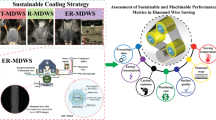Abstract
Remaining useful life prediction is essential for cutting tool utilization evaluation and replacement decision-making. However, it is very difficult to build a mechanism model for the time-varying and non-linear cutting tool wear and life decreasing process. Based on big samples, artificial intelligence–based models have weak interpretability and un-quantized uncertainty. In fact, the cutting tool degradation is a stochastic process, and cutting tool remaining useful life is a random variable. Then, a non-linear Wiener-based cutting tool wear and remaining useful life prediction model is proposed for a specific cutting tool. The probability density function of remaining useful life is derived to quantize uncertainty. On the basis of Bayesian model, unknown parameters are estimated and updated by using history data and real-time data, respectively. Measurement variability is also considered to improve the accuracy and reliability. Experimental study verifies the approach’s effectiveness and accuracy. Detailed comparisons validate the approach’s advantages over existing models. By quantizing the uncertainty of cutting tool remaining useful life prediction with confidence intervals, the model is meaningful for cutting tool selection and replacement decision-making.







Similar content being viewed by others
References
Lei Y, Li N, Guo L, Li N, Yan T, Lin J (2018) Machinery health prognostics: a systematic review from data acquisition to RUL prediction. Mech Syst Signal Process 104:799–834
Sun H, Zhang X, Niu W (2016) In-process cutting tool remaining useful life evaluation based on operational reliability assessment. Int J Adv Manuf Technol 86:841–851
Gokulachandran J, Padmanaban R (2018) Prediction of remaining useful life of cutting tools: a comparative study using soft computing methods. Int J Proc Manag Benchmark 8(2):156–181
Laddada S, Benkedjouh T, Chaib, Drai R (2017) A data-driven prognostic approach based on wavelet transform and extreme learning machine. In: The 5th International Conference on Electrical Engineering. Boumerdes pp. 1–4
Shaban Y, Yacout S (2016) Cutting tool remaining useful life during turning of metal matrix composites. In: 2016 Annual Reliability and Maintainability Symposium (RAMS). Tucson pp:1–6
Wang P, Gao R (2015) Adaptive resampling-based particle filtering for tool life prediction. J Manuf Syst 37:528–534
Salonitis K, Kolios A (2020) Force-based reliability estimation of remaining cutting tool life in titanium milling. Int J Adv Manuf Technol. https://doi.org/10.1007/s00170-019-04883-9
Zhou J, Zhao X, Gao J (2019) Tool remaining useful life prediction method based on LSTM under variable working conditions. Int J Adv Manuf Technol 104(9–12):4715–4726
Hanachi H, Yu W, Kim Y, Liu J, Mechefske CK (2019) Hybrid data-driven physics-based model fusion framework for tool wear prediction. Int J Adv Manuf Technol 101(9–12):2861–2872
An H, Wang GF, Dong Y, Yang K, Sang LL (2019) Tool life prediction based on Gauss importance resampling particle filter. Int J Adv Manuf Technol 103(9–12):4627–4634
Si X, Hu C, Zhang Z (2017) Data-driven remaining useful life prognostics techniques. National Defense Industry Press and Springer-Verlag GmbH, Beijing
Zhang Z, Si X, Hu C, Lei Y (2018) Degradation data analysis and remaining useful life estimation: a review on Wiener-process-based methods. Eur J Oper Res 271:775–796
Huang Z, Xu Z, Ke X, Wang W, Sun Y (2017) Remaining useful life prediction for an adaptive skew-Wiener process model. Mech Syst Signal Process 87:294–306
Wang Z, Hu C, Wang W, Si X (2014) An additive wiener process-based prognostic model for hybrid deteriorating systems. IEEE Trans Reliab 63:208–222
Wang D, Tsui K (2018) Brownian motion with adaptive drift for remaining useful life prediction: revisited. Mech Syst Signal Process 99:691–701
Liu J, Xie J, Zuo J, Zhang M (2015) Residual lifetime prediction for aero-engines based on wiener process with random effects. Acta Aeronautica Et Astronautica Sin 36(2):564–574
Sun H, Cao D, Zhao Z, Kang X (2018) A hybrid approach to cutting tool remaining useful life prediction based on the wiener process. IEEE Trans Reliab 67:1294–1303
Boing D, Castro FL, Schroeter RB (2020) Prediction of PCBN tool life in hard turning process based on the three-dimensional tool wear parameter. Int J Adv Manuf Technol 106(1–2):779–790
Astakhov VP (2014) Machinability: existing and advanced concepts. In: Dvaim JP (ed) Machinability of advanced materials. Waley, London, pp 1–56
Astakhov VP (2017) Improving sustainability of machining operation as a system endeavor. In: Davim JP (ed) Measurement in machining and tribology. Springer, Switzerland, pp 1–29
PHM Society Conference Data Challenge (2010). PHM Society. https://www.phmsociety.org/competition/phm/10. Accessed 17 December 2017
Tobon-Mejia D, Medjaher K, Zerhouni N (2012) CNC machine tool’s wear diagnostic and prognostic by using dynamic Bayesian networks. Mech Syst Signal Process 28:167–182
Wang X (2016) Tool wear monitoring and remaining useful life prognostics. Huazhong University of Science and Technology, Wuhan
Funding
The research received financial support from the National Natural Science Foundation of China (NSFC, no.: 51875475) and the Natural Science Basic Research Plan in Shaanxi Province of China (no. 2018ZDXM-GY-068).
Author information
Authors and Affiliations
Corresponding author
Additional information
Publisher’s note
Springer Nature remains neutral with regard to jurisdictional claims in published maps and institutional affiliations.
Rights and permissions
About this article
Cite this article
Sun, H., Pan, J., Zhang, J. et al. Non-linear Wiener process–based cutting tool remaining useful life prediction considering measurement variability. Int J Adv Manuf Technol 107, 4493–4502 (2020). https://doi.org/10.1007/s00170-020-05264-3
Received:
Accepted:
Published:
Issue Date:
DOI: https://doi.org/10.1007/s00170-020-05264-3




